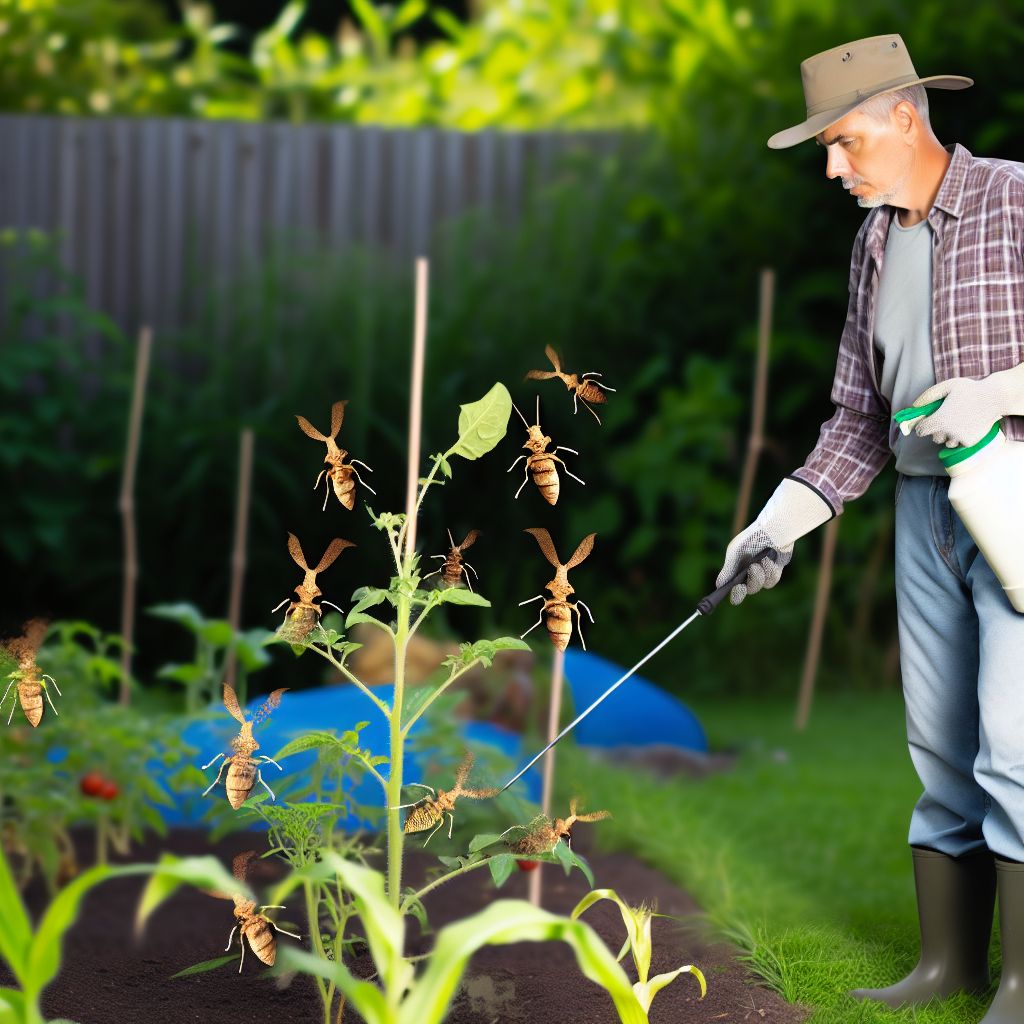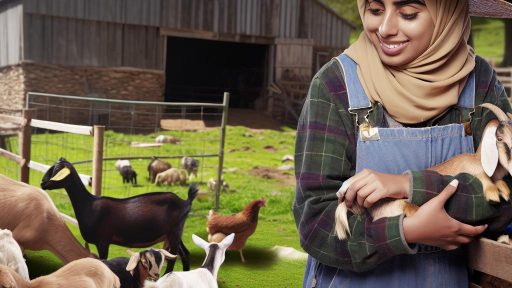Introduction to Companion Planting and Its Importance in Organic Farming
Companion planting plays a vital role in organic farming.
It involves planting different crops in proximity for mutual benefits.
This practice enhances crop growth while deterring pests naturally.
Additionally, companion planting encourages biodiversity in the garden.
Farmers value this technique for its ecological advantages.
Benefits of Companion Planting
Companion planting offers numerous benefits to farmers.
One key advantage is pest management.
Certain plants repel harmful insects.
For example, marigolds effectively deter nematodes.
Moreover, some plants enhance the growth of their neighbors.
Corn, beans, and squash thrive together in a classic trio.
Building Healthy Soil
Another benefit includes enhancing soil health.
Companion plants can improve nutrient availability.
Legumes, such as clover, fix nitrogen in the soil.
This enhances soil fertility for subsequent crops.
Transform Your Agribusiness
Unlock your farm's potential with expert advice tailored to your needs. Get actionable steps that drive real results.
Get StartedAdditionally, companion plants can reduce soil erosion.
Attracting Beneficial Insects
Companion planting also attracts beneficial insects.
Pollinators, like bees, are drawn to diverse plantings.
Moreover, certain plants lure predatory insects that feast on pests.
For instance, dill attracts parasitic wasps that feed on caterpillars.
Reducing Weeds
Companion plants can effectively suppress weed growth.
Certain dense plantings shade the soil, limiting weed development.
This reduces competition for resources among crops.
As a result, farmers can achieve higher yields.
Importance of Companion Planting in Sustainable Agriculture
Companion planting is crucial for organic farming.
This method aids in pest control, soil health, and biodiversity.
Farmers should consider integrating this practice into their fields.
Doing so can lead to more sustainable and productive cropping systems.
The Basics of Pest Management: Understanding Organic Practices
Introduction to Organic Pest Management
Organic pest management focuses on natural solutions for pest control.
This approach emphasizes preventive measures rather than reactive solutions.
Farmers use various strategies to manage pests while minimizing ecological damage.
Core Principles of Organic Practices
Organic pest management is guided by several key principles.
Firstly, understanding the life cycle of pests is essential.
This knowledge informs effective timing for interventions.
Secondly, promoting biodiversity helps in controlling pest populations.
Diversity attracts beneficial insects that can help in pest control.
Complementary Strategies in Organic Pest Management
Integrated Pest Management (IPM) is a widely used approach.
IPM combines biological, cultural, and mechanical practices.
Crop rotation can effectively disrupt pest life cycles.
Showcase Your Farming Business
Publish your professional farming services profile on our blog for a one-time fee of $200 and reach a dedicated audience of farmers and agribusiness owners.
Publish Your ProfileMoreover, physical barriers can limit pest access to crops.
Understanding Companion Planting
Companion planting plays a significant role in organic pest management.
This technique involves planting specific plants together for mutual benefits.
For instance, certain plants can repel pests or attract beneficial insects.
These strategies enhance both plant health and yield.
Sustainable Practices in Organic Farming
Sustainable practices are integral to successful organic pest management.
Regular monitoring of pest populations aids in early detection.
Additionally, maintaining healthy soil promotes plant resilience.
Healthy plants are less susceptible to pest infestations.
Fostering Healthier Ecosystems
Organic pest management combines various strategies.
Emphasizing biodiversity and sustainable practices is key.
Ultimately, this approach fosters healthier ecosystems and farms.
How Companion Planting Works
The Science Behind Plant Relationships
Companion planting relies on the interactions between different plant species.
These interactions can enhance growth and deter pests effectively.
Plants can release chemicals into the soil and atmosphere, influencing neighboring plants.
Some plants attract beneficial insects that prey on common pests.
Others can repel harmful pests with strong scents or toxic substances.
Types of Plant Interactions
Companion plants can promote growth through various mechanisms.
For instance, legumes fix nitrogen in the soil, benefiting nearby crops.
- Legumes like clover and peas enrich the soil.
- Plants like marigolds repel nematodes and other harmful pests.
- Herbs such as basil can enhance the flavor and growth of nearby vegetables.
Mutualism and Allelopathy
Mutualism describes beneficial relationships between plants and other organisms.
This interaction can lead to increased yield and pest resistance.
On the other hand, allelopathy involves one plant suppressing another’s growth.
Some plants release allelopathic compounds to inhibit weeds effectively.
These relationships can lead to healthier ecosystems in gardens and farms.
Practical Applications in Gardens
Gardeners can utilize companion planting to manage pests naturally.
For example, planting garlic near roses can deter aphids.
Furthermore, interplanting can maximize space and resources in gardens.
This practice leads to more diverse and resilient ecosystems.
It also reduces reliance on chemical pesticides for pest control.
Uncover the Details: Indoor Gardening Challenges for Maintaining a Pest-Free Environment
Top Companion Plants for Pest Control
Marigolds
Marigolds are excellent companions in the garden.
They emit a scent that wards off nematodes and other pests.
Additionally, they attract beneficial insects like ladybugs.
Basil
Basil pairs well with tomatoes and peppers.
It repels pests such as aphids and whiteflies effectively.
Moreover, its fragrance enhances the flavor of nearby crops.
Nasturtiums
Nasturtiums serve as traps for aphids and caterpillars.
They prevent these pests from damaging surrounding vegetables.
Furthermore, nasturtiums are edible, adding beauty to salads.
Garlic
Garlic’s strong odor keeps many pests at bay.
Showcase Your Farming Business
Publish your professional farming services profile on our blog for a one-time fee of $200 and reach a dedicated audience of farmers and agribusiness owners.
Publish Your ProfileIt can repel spider mites and various insects.
Planting garlic near roses can enhance their vigor and resilience.
Chives
Chives are beneficial for growing alongside carrots.
They deter carrot fly and enhance overall plant health.
Additionally, chives produce beautiful purple flowers.
Companion Planting Strategies
Utilizing companion planting requires careful planning.
Choose plants that benefit one another in your garden.
For successful pairings, consider each plant’s needs.
Creating Diverse Plantings
Diversity in plant selections increases pest resistance.
Include various companion plants for effective pest management.
This approach attracts a wider range of beneficial insects.
Uncover the Details: Permaculture Agroforestry Techniques for Sustainable Land Use
Case Studies: Successful Implementation of Companion Planting in Organic Farms
Enhancing Tomato Yields with Basil
Basil planted alongside tomatoes helps deter pests effectively.
This companion planting strategy increases both crop yield and flavor.
A study on Green Valley Farms showcased a 30% yield increase.
Furthermore, basil attracts beneficial insects like bees and ladybugs.
Farmers reported improved pollination rates and healthier plants.
Carrots and Onions: A Natural Defense
At Happy Acres Organic Farm, carrots and onions are grown together.
This pairing reduces carrot flies and onion maggots significantly.
Farmers noticed a decrease in pest damage on both crops.
Moreover, the co-planted crops thrive in similar soil conditions.
This approach leads to higher productivity on the same land area.
Legumes and Corn: Maximizing Soil Nutrients
A team at EcoHarvest demonstrated the benefits of planting legumes with corn.
Legumes enrich the soil with nitrogen, benefiting corn growth.
This technique results in robust corn plants and better yields.
Additionally, legumes break the cycle of common soil pests.
Farmers observed healthier crop rotation and reduced dependency on fertilizers.
Marigolds: Protecting Vegetables from Pests
Sunny Fields Organic Farm integrated marigolds into their vegetable plots.
This colorful flower naturally repels nematodes and aphids.
As a result, vegetable plants show less pest damage and better growth.
Farmers enjoyed an aesthetically pleasing and productive garden.
Furthermore, marigolds attract pollinators, enhancing overall biodiversity.
Implications of Companion Planting
These case studies illustrate the effectiveness of companion planting.
Farmers engaged in organic practices reap multiple benefits.
Through strategic plant combinations, crop yield and health improve.
Moreover, these practices foster ecological balance in agricultural systems.
Explore Further: DIY Garden Projects for No-Till Gardening

Challenges and Limitations of Companion Planting for Pest Management
Complexity of Plant Interactions
Companion planting involves complex interactions among different plant species.
Each plant can attract or repel various pests in unpredictable ways.
Additionally, some plants may compete for resources instead of cooperating.
Showcase Your Farming Business
Publish your professional farming services profile on our blog for a one-time fee of $200 and reach a dedicated audience of farmers and agribusiness owners.
Publish Your ProfileThis complexity can make it difficult to achieve desired pest management outcomes.
Local Environmental Conditions
Environmental factors greatly influence the effectiveness of companion planting.
Soil type, moisture levels, and local climate affect plant growth and interactions.
For instance, extreme weather can hinder the success of companion plants.
Moreover, the presence of specific pests varies by location and season.
Limited Scientific Research
Research on companion planting is still relatively limited.
Many claims are based on anecdotal evidence rather than rigorous studies.
Consequently, growers may not have reliable data to guide their decisions.
This lack of research can lead to misinformed choices in pest management strategies.
Pest Resistance and Adaptation
Pests may develop resistance to the defense mechanisms of companion plants over time.
Without proper monitoring, growers might find companion planting becoming less effective.
This adaptation requires continuous innovation in planting strategies to maintain effectiveness.
Thus, reliance on companion planting alone may not suffice for long-term pest control.
Resource Intensive Practices
Successful companion planting often requires extensive planning and management.
Growers must consider timing, placement, and compatibility of different species.
These resource-intensive practices may not be feasible for all gardeners.
Smaller or novice gardeners could find these challenges overwhelming.
Potential for Ineffective Combinations
Not all companions produce beneficial outcomes when planted together.
Some pairings might lead to poor growth or increased pest problems.
Failure to identify appropriate combinations can waste valuable time and resources.
As a result, it’s crucial for gardeners to research before planting companions.
Gain More Insights: Using Native Pollinators To Enhance Biodiversity In Community Garden Spaces
Best Practices for Implementing Companion Planting Strategies Effectively
Understanding Companion Planting
Companion planting involves growing different plants together for mutual benefits.
This method helps deter pests and enhance plant growth.
Additionally, it improves soil health and biodiversity in the garden.
Selecting Compatible Plants
Choosing the right companion plants is crucial for success.
Some plants work well together, while others can hinder each other’s growth.
For example, basil enhances the flavor of tomatoes and repels pests.
On the other hand, planting onions near carrots can stunt their growth.
Research compatibility before planting to increase effectiveness.
Planning Plant Placement
Proper planning boosts the benefits of companion planting.
Consider the height, spread, and growth habits of each plant.
Tall plants can provide shade for shorter ones, promoting growth.
Group plants that have similar needs in terms of water and sunlight.
Timing Your Planting
Timing can significantly impact the success of companion planting.
Different plants have varying growth cycles and requirements.
Plant early bloomers alongside late bloomers to maximize space.
This ensures that your garden remains productive throughout the growing season.
Monitoring and Adjusting Strategies
Regular monitoring allows for timely adjustments in your planting strategy.
Observe how plants interact with each other and modify as necessary.
Showcase Your Farming Business
Publish your professional farming services profile on our blog for a one-time fee of $200 and reach a dedicated audience of farmers and agribusiness owners.
Publish Your ProfileRemove any struggling plants to free up resources for healthy ones.
Keeping records can help in better planning for future seasons.
Utilizing Natural Pest Deterrents
Many companion plants act as natural pest deterrents.
Marigolds, for instance, repel nematodes and other harmful insects.
Integrate these plants strategically to protect vulnerable crops.
This method minimizes reliance on chemical pesticides.
Enhancing Soil Health
Companion planting can improve soil health over time.
Certain plants enrich the soil with essential nutrients.
For example, legumes fix nitrogen, benefiting neighboring plants.
Rotate plantings each season to maintain soil vitality.
Maintaining Biodiversity
Incorporating a variety of plants fosters biodiversity in your garden.
Higher biodiversity can lead to healthier ecosystems and pest management.
Mixing flowering plants with vegetables attracts beneficial insects.
Educating Yourself Continually
Staying informed about companion planting enhances your skills.
Read books, attend workshops, and join gardening communities.
Sharing experiences can provide valuable insights and foster creativity.
Future Trends in Organic Pest Management: The Evolving Role of Companion Planting
The Growing Importance of Biodiversity
Increasing biodiversity in gardens enhances pest management effectiveness.
Companion planting promotes diverse plant relationships.
This diversity attracts beneficial insects that prey on pests.
Moreover, it encourages a balanced ecosystem.
Innovative Techniques in Companion Planting
New methods for companion planting are emerging rapidly.
Farmers are experimenting with different plant combinations.
These combinations can deter specific pests effectively.
For example, planting marigolds next to tomatoes can repel nematodes.
Additionally, integrating herbs with vegetables boosts flavor and health.
Research and Understanding
Ongoing research is revealing more about companion planting benefits.
Scientists are studying plant interactions to identify optimal pairings.
Understanding the chemistry between plants informs better practices.
Furthermore, research highlights how companion planting reduces pesticide use.
Technology in Organic Pest Management
Technological advancements are transforming organic practices.
Farmers are utilizing apps for identifying pest threats.
Such tools enhance the adoption of companion planting strategies.
By using data, growers can make informed planting decisions.
Community and Educational Initiatives
Community gardening programs are emphasizing companion planting.
Workshops teach participants about effective plant relationships.
Education increases awareness and accessibility for novice gardeners.
Additionally, sharing successes encourages wider adoption of practices.
Future Perspectives
The future of organic pest management is bright.
Integrating companion planting into broader agricultural practices will grow.
As sustainability becomes a priority, these methods will gain popularity.
Showcase Your Farming Business
Publish your professional farming services profile on our blog for a one-time fee of $200 and reach a dedicated audience of farmers and agribusiness owners.
Publish Your ProfileUltimately, embracing these trends can lead to healthier ecosystems.
Additional Resources
Three Sisters Gardening Archives – Four String Farm Four String Farm
Olla Pots and Companion Planting: Creating a Symbiotic Garden




